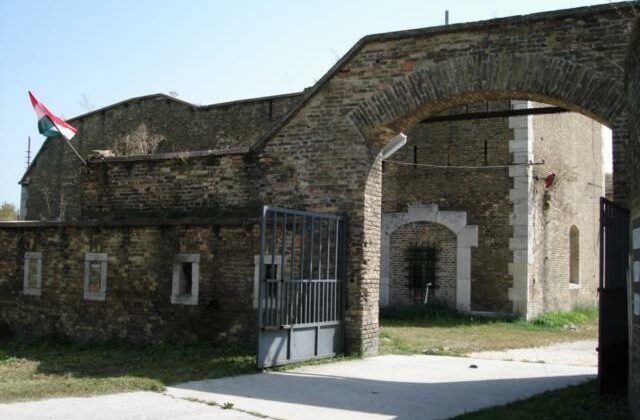Authentic Sites and Holocaust Remembrance in Hungary online conference
Date: 21 June 2021 at 2 p.m. CET
Language: English/Hungarian simultaneous translation
On June 21, 2021, the Holocaust Memorial Center is organizing a one-day online conference Authentic Sites and Holocaust Remembrance in Hungary, in cooperation with the International Holocaust Remembrance Alliance (IHRA) Safeguarding Sites project team.
Some of these sites are places of pilgrimage and places to mourn victims. They serve also as places of education, where young generations may learn about the history of the Holocaust. In spite of their importance, many of the places, where important events took place has been altered beyond recognition or disappeared completely during the eight decades since the end of WWII. Losing these sites means losing evidence and makes safeguarding historical record more difficult.
The situation in Hungary is particularly grave in this respect. Every tenth victim of the Holocaust was Hungarian, but the vast majority of them were killed away from the country, in Auschwitz and other camps in Germany, or as forced labor servicemen on the Eastern Front. There is hardly an authentic site in Hungary that can be linked to the Holocaust or to the Roma genocide, which is suitable to help the memory in the public consciousness in connection with the Shoah. For remembrance, it is needed to establish the list of the authentic sites and determine which of them are suitable to contribute more than ever to the maintenance of the memory of the Shoah.
This is the aim of the conference on 21 June. We’ll review how official memory policy and our shared memory have changed since World War II. What efforts are being made today to nurture Holocaust remembrance? Why did the atrocities against the Roma drift to the periphery of memory? And finally, which venues would be suitable to make them easier to preserve the memory of the victims by bringing them into the public consciousness.
In order to take part to the conference, please register at https://bit.ly/2ReyVOl

In the background, the brick yard in Óbuda, 1939. It was the starting point of death marches of tens of thousands of Jews from Budapest at the end of 1944. © Fortepan/Pálfi András
Program
Section I Holocaust, Roma Genocide and Remembrance in Hungary
Chair: Tamás Kovács
14:00 – 14:10 Opening remarks – Tamás Kovács
14:10 – 14:40 From “Literature of Experience” to “Concentration Camp Literature” – Representations of the Holocaust Remembrance in Hungarian Literature after 1945 and in the 1950s – Tamás Kisantal
14:40 – 15:10 Illustrated Stories about the Memory of the Roma Holocaust in Hungary – Anna Lujza Szász
15:10 – 15:40 The Challenge of Safeguarding Sites – Gilly Carr
15:40 – 16:00 Q & A
16:00 – 16:15 Coffee break
Section II Authentic sites of the Holocaust and Roma genocide in Hungary
Chair: László Csősz
16:15 – 16:45 Politics of Remembrance in Hungary – Réka Földváryné Kiss
16:45 – 17:15 The Mass Murder in Cservenka/Crvenka – Tamás Csapody
17:15 – 17:35 Mass execution of Roma at Lake Grábler – József Harmat
17:35 – 17:55 The Sárvár Internment Camp – Zsolt Bajzik
17:55 – 18:15 Internment Camp in Kistarcsa – Tamás Kovács
18:15 – 18:35 Revonstruction of the Star Fortress, Komárom – István Mányi
18:35 – 18:50 Q & A
18:50 Summary and concluding remarks
Lecturers:
Dr. Gilly Carr is a Fellow of St Catharine’s College, a Member of the McDonald Institute of Archaeological Research, and Senior Lecturer and Academic Director in Archaeology at the Institute of Continuing Education. She is also a member of the UK delegation of IHRA, the International Holocaust Remembrance Alliance, and a Partner of the Cambridge Heritage Research Centre. She works in the field of Conflict Archaeology and Heritage Studies and is currently chairing an International five year IHRA project on the subject of Holocaust and Roma genocide sites, entitled ‘Safeguarding Sites: the IHRA Charter for best practice’. This project aims to create heritage guidelines for international adoption and runs from 2019-2023.
One of her recently completed project is ‘Nazi camps on British soil’ (2012-16) that concerned the archaeology and heritage of forced and slave labour in the Channel Islands. The British Academy and McDonald Institute for Archaeological Research has supported the excavations of Lager Wick, a forced labour camp in Jersey.
In 2020, the European Association of Archaeologists awarded Dr. Carr the European Heritage Prize for her work on victims of Nazism.
Dr. Tamás Csapody is lawyer, sociologist, bioethicist, political scientist. He is a researcher of the history of Hungarian labor servicemen taken to Yugoslavia (Serbia) during the Second World War. He processed the history of laborer servicemen belonging to Jews and small churches (Jehovah’s Witness, Nazarene, Reform Adventist) sent to the Bor mining area in three separate volumes.
He has published a total of six books, numerous professional studies and newspaper articles.
Dr. Réka Kiss Földváryné is a historian and ethnographer. She studied in Hungary, Denmark and Scotland. From 2000 she worked at the Research Institute of Ethnography of the Hungarian Academy of Sciences, from 2012 as a senior researcher. She was a guest lecturer at the Department of Cultural History and Contemporary Hungarian History of the Eötvös Loránd University.
Her main research interests are: the relationship between church and state in Hungary during the communist dictatorship; retaliation following the 1956 revolution and related political lawsuits; Social history after 1945. She is the author, co-author and editor of ten books and nearly eighty studies.
Dr. Anna Lujza Szász, sociologist, lecturer at the foreign program of the Corvinus University of Budapest, curator of the OFF-Biennale Budapest RomaMoMa platform. Her main research topics are: memory politics, Roma genocide, contemporary art.
